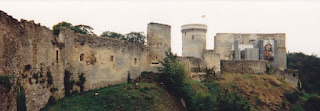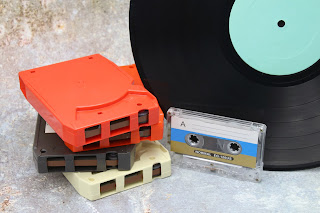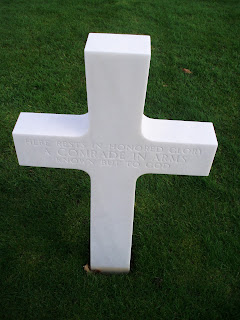Photography has come a long way in my lifetime. The massive cameras that were on a tripod and required the photographer to go under a sheet (there's probably a better term for it) were before my time, but I have still seen a lot of change. Camera attachments (such as lenses) were often larger than they are today. We had to buy rolls of film to thread into the camera. (We used empty cylindrical film cartridge containers in the swimming unit in PE when we were learning to dive, and we had to retrieve them from the bottom of the pool.)
 |
Camera with negatives |
There were several kinds of camera when I was younger, but most of them involved threading the film. After opening the camera and threading the film in, you had to close it, and it was very important not to open it again until the roll was done. Otherwise the film would be exposed to the light and the pictures would come out white, and depending on how exposed they were, sometimes blank. We called it overexposed. Different kinds of camera required different kinds of film. 35mm (millimeter) cameras needed to be threaded:
110 cameras (I had one) were cheaper than 35mm, and the pictures weren't as good quality, but they did not require threading. Their film cartridges looked like this:
Each roll of film had a set number of pictures on it. In the above pictures, the 35mm film has 36 pictures on it and the 110 film has 24. Once you had taken a picture, you usually had to advance the camera to the next picture, and a number on the camera indicated how many pictures remained on the roll. When taking pictures, there were a few things to consider: Rolls of film cost money. Getting the pictures developed cost money. Was this subject really something we wanted to pay to have a print made? How many pictures were left on the roll? If we ran out of film before the day or event or adventure was done, we couldn't take any more pictures! We had to think twice before taking a picture. Most cameras did not give the option to view the picture, so you wouldn't know how it turned out until days or weeks later when you took the finished roll to the store or other place where they developed pictures.
We generally left the developing to the professionals, who did it in a darkroom, so called because it had to be dark in there to avoid exposing the pictures. They generally had just enough light so people could see what they were doing.
Once we got the pictures back, they came in an envelope of prints and negatives (picture of negatives at the top of this post). The prints were the picture on glossy photo paper. The negatives were strips of film with the pictures in inverted colors. If we wanted more copies at a later date, we could take the negatives in and have them make prints from the negatives.
Then there was the Polaroid. This camera did not involve threading film or even taking it in to be developed. You put the stiff photo sheet in, snapped the picture, and the camera spat the sheet out. The glossy part was generally gray at first. We usually shook them back and forth a bit to speed up the process, but the picture on the sheet gradually came into focus. Like the 110 pictures, they were not as good quality as the 35mm, but they were nice if you needed the picture right away. Polaroid photos also had paper around the glossy part so you could handwrite a caption if you wanted.
They also came out with disposable cameras. These were sealed shut, and came with the film in them. Once you finished the roll, you would take the whole camera in to get it developed. You got pictures back with negatives, but the camera could not be reused.
Panoramic cameras were pretty nifty. The resultant pictures were about the same height as regular prints, but about double the width. In landscape orientation, it was the photographic equivalent of the widescreen format in movies (or in portrait orientation, tall and thin). When I went to France in 1999, I went with a panoramic camera and a couple disposable ones. I need to go back now that I can take better quality pictures and don't have to conserve film!
 |
William the Conqueror's castle in Falaise, France
Picture taken with my panoramic camera |
When we got the pictures back, we either left them in the envelopes and took them out to look at them later, or we stored them in photo albums. Some albums had slots to put the pictures, and some had pages with transparent plastic over them. For those ones, you would peel back the transparent bit, put the pictures on the page, and put the plastic sheet back. It adhered to the page so the pictures wouldn't go anywhere, but was still easy to pull back to rearrange or add pictures (but you shouldn't do that too much because excessive unpeeling and re-peeling could make it less adhesive).
If you wanted to show pictures to a group, you could have slides made. They were small square representations of the picture (with the negative of that picture) that you could put in a slide projector. You arranged the pictures on the turntable on the projector in the order you wanted to show them, and then the light shone through the slide onto a screen. We used them a lot as missionaries when we travelled around to different churches in the US to report on our ministry in the Philippines.
Another option for presentations was to print the picture on a transparency, the size and shape of a regular sheet of paper, but plastic and transparent. Transparencies could also accommodate text and anything else you wanted to put on them. We also used them in church to show the lyrics of worship songs and hymns on the big screen. To show them, we used an overhead projector, which had a flat table-like glass "stage" where you would put the transparency. The stage had light coming up from below it, which shone through the transparency, to the projector above, which in turn reflected and shone onto the screen. Another option, though not nearly as common, was the opaque projector. In that case, you could put a picture or book or whatever you wanted to project in the projector and it would be shown on the screen. Opaque projectors, as indicated in the title, did not require transparencies.
Digital cameras were pretty expensive at first. (The better quality ones still are.) They presented new benefits. No need for threading film, no risk of accidentally opening the camera too soon and exposing the film. Many (though not all) digital cameras gave the option of seeing how the picture turned out on a screen. You could still get prints made, but it was a different process than doing it from film. When shopping for digital cameras, we looked at the number of megapixels. More megapixels indicated better quality and more detail. Some digital cameras can also record video.
These days we have a lot more options than in the past. Overhead and opaque projectors are pretty much obsolete now, as we have PowerPoint and other computer programs and phone apps for presenting things digitally. Photoshop and similar programs offer more ways of editing pictures, improving the quality, combining multiple pictures into one, and more.
I seem to be sensing a theme here, but as with previous subjects in this "Days of Yore" series, I don't generally use any of the above cameras. I use...you guessed it...my cell phone! Photo quality on cell phones has been steadily increasing, and since I love taking pictures, that's one thing I look for when buying one. Someday I hope to be able to afford a fancy digital camera to take even better quality pictures, but in the meantime, my phone takes impressive ones! As people continue to develop smart glasses, some of them also have the capability of taking pictures, though those are currently a bit controversial due to valid privacy concerns, and will need more development before I consider that seriously...but I'm excited about the possibilities!




















.jpeg)